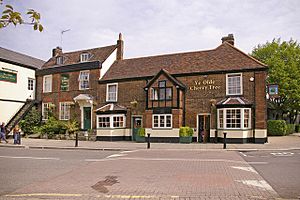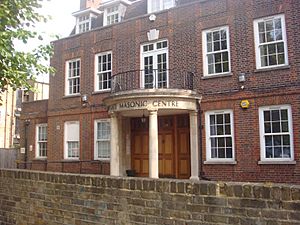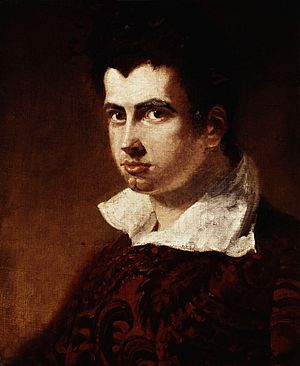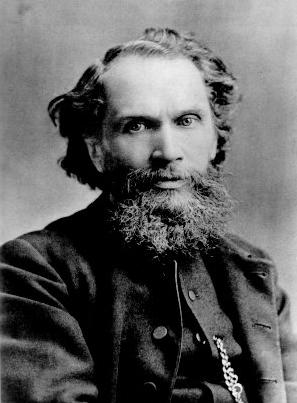Southgate, London facts for kids
Quick facts for kids Southgate |
|
|---|---|
 Southgate underground station |
|
| Population | 14,454 (2011) |
| OS grid reference | TQ296942 |
| London borough | |
| Ceremonial county | Greater London |
| Region | |
| Country | England |
| Sovereign state | United Kingdom |
| Post town | LONDON |
| Postcode district | N14 |
| Dialling code | 020 |
| Police | Metropolitan |
| Fire | London |
| Ambulance | London |
| EU Parliament | London |
| UK Parliament |
|
| London Assembly |
|
Southgate is a suburban area of North London, England in the London Borough of Enfield. It is located around 8 miles (13 km) north of Charing Cross. The name is derived from being the south gate to Enfield Chase.
Contents
Local features
Within the area is the art deco Grade II* Southgate tube station designed by Charles Holden. The surrounding roads have a variety of shops and restaurants including an ASDA. The area has several large green parks such as Grovelands Park which covers ninety-two acres and contains a former boating lake of seven acres adjoining dense woods and bracken. In Waterfall Road is Christ Church, a building of stone which has a tower and spire and was built in 1862 by Sir Gilbert Scott. In the grounds stands the Minchenden Oak, said to be the largest oak tree in England, and rumoured to be 800 years old. Across the road from the church lies the Walker Cricket Ground; a regular Middlesex venue which was first used in 1859 and is named after the cricketer John Walker.
Geography
 |
East Barnet | Oakwood | Winchmore Hill |  |
| Whetstone | Palmers Green | |||
| Brunswick Park | Osidge | Arnos Grove |
Southgate tube station on the Piccadilly line is the nearest tube station to most of Southgate's residential area. The other stations are at Oakwood (to the north) or Arnos Grove (to the south west).
Demography
Southgate is a cosmopolitan district. There has been a prominent Jewish community since the early 20th century. There are also many Greek, Greek Cypriot, Japanese, and Turkish families living in the district. As of the 2011 census, White British makes up 45% of the population, followed by Other White at 20%.
History
Southgate was originally the South Gate of Enfield Chase, the King's hunting grounds. This is reflected in the street names Chase Road (which leads due north from the station to Oakwood, and was formerly the avenue into the Chase) and Chase Side. There is a blue plaque on a building on the site of the south gate. A little further to the south was another small medieval settlement called South Street which had grown up around a village green; by 1829 the two settlements had merged and the village green became today's Southgate Green.
Becoming separate from Edmonton in 1881, Southgate had a population in 1891 of just 10,970. By 1901 the figure had moved up to 14,993, and by 1911 the figure had ballooned to 33,612, aided by the nearby railway station in Palmers Green.
Southgate was predominantly developed in the 1930s: largish semi-detached houses were built on the hilly former estates (Walker, Osidge, Monkfrith, etc.) following increased transport development. In 1933, the North Circular Road was completed through Edmonton and Southgate, and also in 1933, the London Underground Piccadilly line was extended from Arnos Grove (where it had reached the previous year), through Southgate tube station, on to Enfield West (now known as Oakwood). This unleashed a building boom, and by 1939 the area had become almost fully developed.
By 1951, the population had grown to 73,377 - falling by about 1,000 ten years later as many moved to new towns nearby.
Status
In 1894 Southgate was created an urban district of Middlesex by the Local Government Act 1894. In 1933 the district gained further status as a municipal borough. The Municipal Borough of Southgate was abolished in 1965 by the London Government Act 1963 and its area was combined with that of the Municipal Borough of Enfield and the Municipal Borough of Edmonton to form the present-day London Borough of Enfield.
Taverns, inns and public houses
Because of the age of the former village and its position in a ring of villages (the nearby Barnet and Enfield similarly hosting a number of coaching inns) one day's travel by coach from London, Southgate had many pubs: within the village centre there were no fewer than six licensed premises.
Many were located on Chase Side, but in recent times have been mostly replaced by restaurants. The Waggon and Horses closed in 2013, becoming an Anatolian restaurant. The Rising Sun in Chase Side was the terminus for a local horsebus service to Colney Hatch (and there to Kings Cross) before the arrival of the railways, whereupon the service switched to the new station in Palmers Green. It was rebuilt in 1932, and substantially renovated in 2008, changing its name to The Sun. The White Hart is a long-standing pub on Chase Road, near Southgate Circus roundabout.
Opposite the Southgate Club on Chase Side stood The Gate, which was closed in August 1909. The landlord, A. Butcher, took the sign with him to the Fishmonger's Arms in Winchmore Hill Road - which apparently read "This gate hangs well, and hinders none. Refresh and pay - then travel on." While the sign no longer exists, his pub does - rebuilt in the 1930s, the pub owes its name to the nearby ice wells which produced ice for central London fish markets.
In the middle of the 18th century, The Crown (also once known as The Crown Hotel) on Chase Side was a centre of 'much sport'. A caption in a framed picture of a dog discovered by author Herbert W. Newby reads:
Mr. Earl of the 'Crown Inn', Southgate, Nr London, will produce a retriever puppy not over six months old for £10 or £20 that will perform more tricks than any other dog of nine months old in England. He is a beautiful dog, and very large for his age.
The building was originally a wooden two-storey building with a brick gable-end facing the highway. It was rebuilt in 1895 but has since been demolished. The Wetherspoons pub The New Crown occupies a site nearly opposite.
Other notable pubs include Ye Olde Cherry Tree which overlooks Southgate Green to the south of Southgate's main centre, and The Woodman which is on The Bourne.
Religious facilities
Synagogues
There are five synagogues with Southgate in their name,: Cockfosters and North Southgate, Palmers Green and Southgate Synagogue. These two are part of the United Synagogue, also included, but independent, is the Southgate Ilan 'Bel-Air' Kahlani Synagogue, serving Yemenite Jews of Adeni extraction and other Mizrahi Jews. Chabad Southgate also is included.
Southgate Progressive Synagogue is in Oakwood. Southgate and District Reform Synagogue has now moved to Whetstone and changed its name in February 2010 to Sha'arei Tsedek: North London Reform Synagogue.
Churches
Christ Church stands near Southgate Green. This was built on the site of Weld Chapel, which was demolished in 1861. The clock on the church was placed there to celebrate Queen Victoria's diamond jubilee. The church contains London's largest collection of pre-raphaelite stained glass by Morris, Marshall Faulkner & Co (later Morris & Co) and has a fine choir. The Parish Church of St Andrew is on Chase Side. Emmanuel Evangelical Church meets in Ashmole School. Southgate Methodist Church is on The Bourne, near Southgate Underground station. It was built in 1929, replacing a building on Chase Side. It is an active community hub.
Southgate Masonic Centre
The Southgate Masonic Centre is home to 160 Lodges of which 15 are from Middlesex, along with 5 Chapters. The Centre, a converted church hall, was opened in 1968. The Middlesex Lodges that joined had been meeting in pubs and similar venues and welcomed the opportunity to have their own Centre.
Education
College
- Southgate College
- Oak Hill College (in the London Borough of Barnet)
Schools
Primary
- De Bohun Primary School
- St Andrew's CE Primary
- St Monica's RC Primary
- Salcombe Preparatory School (Independent)
- Vita et Pax School (Independent)
- Walker Primary
- West Grove Primary
- Wolfson Hillel Primary
- Osidge Primary School (in the London Borough of Barnet)
Secondary
- Southgate School
- Ashmole Academy (in the London Borough of Barnet)
Notable residents
- Sir William Acton, 1st Baronet, owned Arnolds estate.
- Neville Brody, graphic designer, born in Southgate in 1957.
- Errol Brown, singer.
- James Brydges, 3rd Duke of Chandos, lived at Minchington Hall.
- Raymond Wilson Chambers, writer, lived in Selborne Road, Southgate Green.
- Dave Clark (musician), lived in Chase Side.
- James Colebrooke and George Colebrooke, first owners of Arnos Grove house.
- Sir William Curtis, 1st Baronet; MP, Sheriff and Lord Mayor, lived at Cullands Grove.
- Dave Davies, musician.
- Alan Dumayne, local historian.
- Stephen Godin, 18th Century broker, lived at Cullands Grove.
- Augustus Hare, writer.
- David Hepworth, journalist and writer.
- Sir David Hechstetter, merchant, lived at Minchington Hall.
- Frederick Hitch, awarded the Victoria Cross.
- Sir Abraham Hume, 1st Baronet, owned Arnos Grove house.
- Leigh Hunt, essayist and writer, born in Southgate in 1784.
- Ashley Hutchings, musician, born 1945.
- Peter Jay, drummer, born 1944.
- Selin Kiazim, chef and restaurateur.
- John Lawrence, 1st Baron Lawrence, lived in Southgate House in the 1860s.
- Sir Patrick Linstead, English chemist, born in Southgate in 1902.
- Sir Thomas Lipton came to Southgate in 1892, and lived in Osidge House (in East Barnet, but within the parish of Southgate) until his death in 1931.
- Robert Lowe, 1st Viscount Sherbrooke, 19th Century politician.
- Allastair McReady-Diarmid, awarded the Victoria Cross.
- William Mayne, 1st Baron Newhaven, owned Arnos Grove house.
- Simon Mayo was born in Southgate, 1958.
- Ron Moody, actor.
- Sir John Moore, Lord Mayor, circa 1674.
- David Puttnam, film producer, born in Southgate in 1941.
- Ted Ray (comedian) and Andrew Ray.
- Rob Rinder, barrister and TV judge.
- Henry Crabb Robinson, diarist, circa 1812.
- Dame Flora Robson, star of stage and cinema, lived at 65 The Mall between 1910 and 1921.
- Sarbel, pop singer, born 1981.
- John Henry Powell Schneider and Henry Schneider, lived at Beaver Hall.
- Paul Scott (novelist), lived at various addresses in Southgate and Palmers Green.
- Alan Sinfield, writer and theorist, born 1941.
- Rachel Stevens, S Club 7 star, was born and raised in Southgate and attended Osidge Primary and Ashmole Academy.
- Samuel Sugden, 19th Century merchant, lived at Oak Lodge.
- Richard Temple-Nugent-Brydges-Chandos-Grenville and Anne Temple-Nugent-Brydges-Chandos-Grenville, lived at Minchington Hall.
- Joseph Thornton, railway contractor, lived at Beaver Hall.
- Isaac Walker, and The Walkers of Southgate.
- Benjamin Waugh, founder of the NSPCC, lived at Southgate Green in the 1880s.
- Andrew Weir, 1st Baron Inverforth, owned Arnos Grove house.
- Sir John Weld, 17th century merchant, owned Arnolds estate.
- Sir Thomas Whitmore, 1st Baronet and Sir William Whitmore, 2nd Baronet, owned Arnolds estate.
- Amy Winehouse, (1983–2011), lived at addresses in both Southgate and Osidge, and attended local schools. before moving to Whetstone in 1991.
- Sir Thomas Wolstenholme, Sir John Wolstenholme and Sir Nicholas Wolstenholme of Minchington Hall.
Images for kids
-
Rare survivors of 1930s development: The Southgate Club (built 1889) and adjacent Victorian terrace in Chase Side.
-
Morris & Co. stained glass at Christ Church, Waterfall Road











